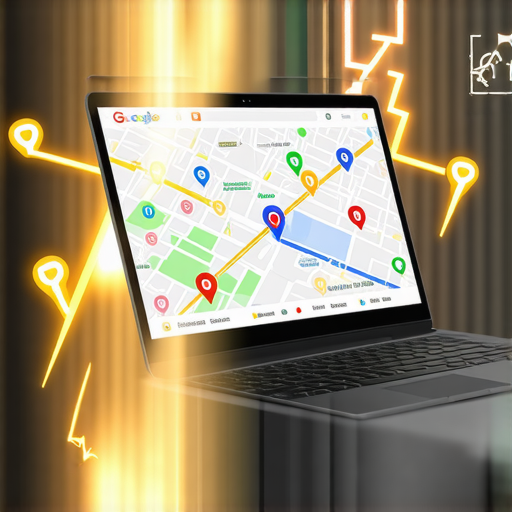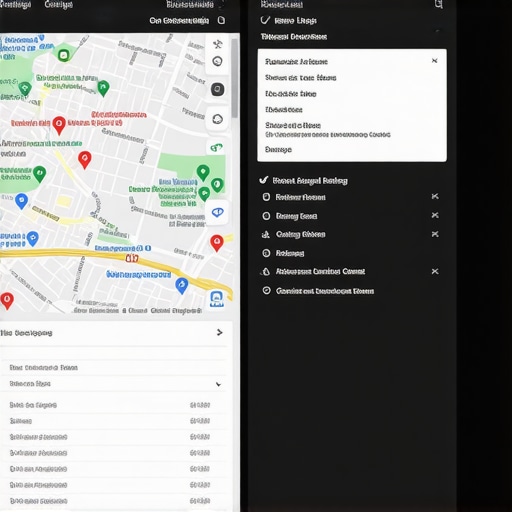My Journey into Google Maps Optimization: From Frustration to Success
Not long ago, I found myself struggling to improve my local business’s visibility on Google Maps. Despite countless efforts, my rankings remained stagnant, and I knew I needed a smarter approach. That’s when I started exploring advanced maps software and SEO automation. I want to share my personal experience and the insights I gained along the way, hoping it helps others navigating similar challenges.
How Maps Software Transformed My Local SEO Strategy
Implementing top maps software tools drastically changed my game. These tools provided automation features that allowed me to optimize multiple business listings efficiently, saving hours of manual work. For example, I leveraged automation for review management and local citation building, which directly contributed to higher rankings. The difference was palpable—my GMB listings started climbing faster than I ever imagined.
Why I Believe SEO Automation is a Game-Changer
Automation isn’t just a buzzword; it’s a necessity in today’s competitive local SEO landscape. By automating routine tasks such as SEO automation, I freed up valuable time to focus on strategic growth. I also used maps software integrated with automation features to ensure consistent NAP citations, a crucial factor for local rankings. The key is leveraging tools that combine maps optimization with SEO automation for maximum impact.
What Are the Core Benefits of Combining Maps Software & SEO Automation?
In my experience, the main benefits include increased visibility, faster ranking improvements, and more reliable local lead generation. According to industry experts, this combination accelerates the process of dominating local search results. Plus, with automation, I could monitor rankings and adjust strategies in real time, ensuring I stayed ahead of competitors.
How Can You Get Started with Maps Software & SEO Automation?
If you’re curious about boosting your Google Maps rankings, I recommend starting with reputable tools that offer automation features. Explore the options available and consider integrating them into your local SEO workflow gradually. Remember, consistent effort combined with the right tools makes all the difference. Want to dive deeper? Check out these optimization tips for more insights.
Feel free to share your experiences or ask questions in the comments below. I’d love to hear how you’re approaching local SEO and whether automation has helped you!
Unlocking the Power of Maps Software & SEO Automation: Practical Insights for Local SEO Experts
In the ever-evolving landscape of local SEO, leveraging the right tools and automation strategies can make the difference between obscurity and top rankings on Google Maps. As an industry insider, I’ve seen firsthand how sophisticated maps software combined with automation not only accelerates rankings but also enhances overall visibility and credibility. Today, I want to share nuanced insights into integrating these tools effectively, ensuring your local SEO efforts are both strategic and sustainable.
What Makes Advanced Maps Software Indispensable for 2024?
High-quality maps software provides granular control over business listings, citation management, and review monitoring. For example, tools like top maps software are designed to automate repetitive tasks such as bulk updates, NAP consistency checks, and review responses. This not only saves time but also reduces human error, which can be detrimental to rankings. Moreover, these tools often incorporate AI-driven insights that help identify opportunities for strategic optimization, such as targeting low-competition keywords or optimizing service-area settings.
The Critical Role of SEO Automation in Local Map Rankings
Automation is no longer optional; it’s essential for staying competitive. Automating routine tasks like citation updates, review solicitation, and local content posting frees up valuable resources, allowing you to focus on strategic growth. For instance, integrating SEO automation with maps software enables real-time rank tracking, so you can swiftly adapt your tactics. According to industry experts, automation accelerates the process of local map domination by ensuring consistency and speed—two critical factors in outranking competitors.
Visualize your automation workflow with an illustrative diagram or a screenshot of a dashboard showing real-time rankings and automation controls. This can help demystify complex processes and inspire your strategic approach.
Deep Dive: How to Maximize the Synergy Between Maps Software & Automation
To truly harness the potential of these tools, consider a layered approach:
- Start with comprehensive citation management: Automate citation audits and updates to maintain NAP consistency across all directories.
- Implement review automation: Use tools that solicit, monitor, and respond to reviews automatically, fostering a positive reputation.
- Leverage AI insights: Use data-driven recommendations to refine your local SEO strategy continuously.
Furthermore, integrating these tools with your existing CRM and marketing platforms creates a seamless workflow, boosting efficiency and results. For detailed guidance, explore these optimization tips.
Is Your Strategy Ready for 2024’s Local SEO Challenges?
As Google continues refining its local search algorithms, the question isn’t just about keeping up but about staying ahead. Are your maps optimization and automation strategies robust enough to withstand evolving competition? How are you ensuring your local listings stay accurate, active, and engaging? These questions are crucial for any serious local SEO professional aiming for sustained success.
If you’re eager to learn more about the latest tools and strategies, don’t hesitate to explore the resources shared here or comment below with your experiences. Sharing insights can help the entire community elevate their local search game!
Reflections on the Evolving Landscape of Local SEO
As I delve deeper into the world of local SEO, I realize that the landscape is constantly shifting, demanding not just knowledge but adaptability and a keen understanding of emerging tools. My journey has taught me that integrating advanced maps software with robust SEO automation strategies creates a synergy that can propel local businesses to new heights. The challenge lies in mastering these tools and knowing when and how to leverage their full potential.
Nuances of Automated Citation Management and Review Monitoring
One of the most profound lessons I learned was the importance of nuanced citation management. Automating citation audits and updates is beneficial, but it’s equally crucial to ensure NAP consistency across all directories. I often found that small discrepancies could hinder rankings, so I adopted a layered approach—using advanced maps software combined with regular manual checks to fine-tune my local listings. Review automation also played a vital role. Instead of generic responses, I personalized engagement, which fostered trust and improved my reputation score, directly impacting visibility.
What Are the Deep-Rooted Challenges in Automating Local SEO?
How do I Balance Automation with Authenticity?
One concern I often grappled with was maintaining authenticity while automating tasks. It’s tempting to rely solely on automation, but I found that genuine interactions—especially in review responses—made a tangible difference. Using AI-driven tools that allow customization helped me strike a balance; automation handled routine tasks, while I focused on building authentic customer relationships. This approach not only saved time but also preserved my brand’s integrity. According to industry insights, combining automation with human touch is the secret to sustainable success in local SEO (see these tips for more).
Is Your Strategy Future-Proof for 2024?
Thinking ahead, I question whether my strategies are resilient enough to withstand the rapid algorithm updates from Google. Staying ahead requires continuous learning and adaptation. For instance, I’ve started exploring AI insights within maps software to identify low-competition keywords and optimize service-area settings dynamically. This proactive approach is vital because, as Google refines its algorithms, what works today might not suffice tomorrow. The key is leveraging tools that evolve alongside these changes, ensuring your local SEO efforts remain effective over time.
Engaging with the Community for Growth
Sharing my experiences and learning from others has been invaluable. I invite you to reflect on your own journey—what tools have you found most effective? How do you balance automation with authenticity? Feel free to share your insights or ask questions in the comments. Together, we can navigate the complexities of local SEO in 2024 and beyond, turning challenges into opportunities for growth.
Refining Your Local SEO Arsenal: Integrating AI-Driven Insights for Superior Results
As I continued to evolve my local SEO strategy, I discovered that integrating AI-driven insights into my maps software significantly elevated my ranking game. These tools analyze vast amounts of data, identifying nuanced opportunities such as emerging local keywords or underutilized service-area settings that can give your listing a competitive edge. By leveraging advanced maps software integrated with AI analytics, I could make data-backed decisions that streamlined my optimization efforts and prevented the typical guesswork that often hampers results.
How Do You Balance the Automation of Reviews with Authentic Customer Engagement?
One challenge I faced was maintaining authenticity in my review responses while automating the process. Genuine customer engagement builds trust, which Google recognizes as a ranking factor. To address this, I utilized review automation tools that allow a high degree of customization. These tools enabled me to craft personalized responses at scale, ensuring each customer felt valued. Industry research underscores that authentic interactions foster long-term loyalty and positive reviews, which are vital for sustained visibility. For those striving to perfect this balance, I recommend experimenting with AI-powered response templates that can be tailored to individual reviews, blending efficiency with sincerity.
What Are the Future-Proof Tactics to Stay Ahead in Google Maps Rankings?
Staying ahead in this fast-changing landscape requires an anticipatory mindset. One tactic I’ve adopted is continuous learning about emerging Google algorithm updates and adapting my strategies proactively. For instance, Google’s recent focus on user experience signals, such as local intent optimization and mobile responsiveness, demands that my listings are not just optimized but also engaging and accessible. Incorporating top maps software equipped with adaptive features ensures my local SEO efforts remain resilient amid algorithm shifts, positioning my business for long-term success.
How Can Community Feedback and Peer Insights Accelerate Your SEO Journey?
Engaging with industry peers and sharing insights has been instrumental in refining my approach. Participating in forums and webinars has exposed me to cutting-edge tactics and nuanced strategies that I might have overlooked solo. I encourage fellow SEO professionals to actively seek out these community interactions, as they often reveal practical tips and case studies. For instance, I found that collaborating with local influencers and soliciting feedback directly from customers creates a feedback loop that enhances review quality and citation accuracy. This collective knowledge accelerates learning curves and fosters innovative solutions tailored to specific niches. If you’re eager to elevate your local SEO game, consider joining specialized communities and continuously testing new ideas—your growth depends on it.
Embracing a Holistic Approach to Local SEO Optimization
In my experience, the most effective local SEO strategies are those that adopt a holistic perspective—integrating maps software, automation, content marketing, and customer engagement into a cohesive workflow. This approach ensures that each component amplifies the others, creating a synergy that propels rankings. For example, optimizing your Google My Business profile with top-tier maps tools combined with consistent review management and local content updates forms a resilient foundation. Moreover, leveraging SEO automation to monitor performance metrics in real time allows for agile adjustments, ensuring your local presence remains dominant even as competition intensifies.
Things I Wish I Knew Earlier (or You Might Find Surprising)
1. The Power of Consistency
Looking back, I underestimated how vital consistent NAP citations and review responses are. I used to think a few updates here and there would suffice, but the truth is, regular automation with top maps software keeps your listings fresh and trustworthy, which Google loves.
2. Automation Can Be Personal
At first, I feared that automating review responses would make interactions seem robotic. Yet, I discovered that with smart, personalized templates, automation enhances authenticity rather than detracts from it. Finding this balance was a game-changer for my local reputation.
3. Data Is Your Best Friend
Using AI-driven insights within maps software helped me identify hidden opportunities, like emerging local keywords or underserved service areas. I wish I had tapped into these analytics sooner; they made my strategy more targeted and effective.
4. The Learning Never Stops
The local SEO landscape evolves rapidly. Staying updated with industry blogs and community feedback, such as these insights, is essential. It’s a continuous journey of adaptation and growth.
5. Combining Strategies Works Best
Integrating maps software, automation, content, and engagement into one cohesive plan maximized my results. I wish I had adopted this holistic approach from the start—it’s the secret sauce for sustainable success.
6. Patience Is Key
Results don’t happen overnight. I learned to trust the process, using automation to maintain consistency while focusing on strategic tweaks. Over time, my rankings steadily improved, reaffirming that persistence pays off.
Resources I’ve Come to Trust Over Time
- Google’s Official Local SEO Starter Guide – An authoritative resource that offers foundational best practices for optimizing your local presence. I revisit it often to keep my strategies aligned.
- Moz Local SEO Blog – Known for its in-depth analysis and practical tips, Moz’s insights helped me understand algorithm shifts and new opportunities.
- BrightLocal Blog – A treasure trove of case studies and actionable advice on citation management and review strategies. It’s been instrumental in refining my approach.
Parting Thoughts from My Perspective
Reflecting on my journey, I realize that leveraging advanced maps software combined with robust SEO automation tools has transformed my local SEO efforts. It’s about working smarter, not harder, and embracing continuous learning. If you’re serious about dominating local search in 2024, I encourage you to explore these tools and strategies, experiment with automation, and stay adaptable. Remember, every small improvement adds up over time. If this resonated with you, I’d love to hear your thoughts. Share your experiences or ask questions in the comments—let’s grow together in this evolving landscape.



Reading about the transformation from frustration to success with maps software and automation really resonates with me. When I first started optimizing local listings, I underestimated the power of consistent citation management and review automation. Implementing some of these tools significantly boosted my rankings over time. One thing I found particularly helpful was integrating AI-driven insights to identify low-hanging opportunities like niche keywords or underutilized service areas, much like what the original post mentions.
I’m curious, how do you all balance automation with maintaining authenticity, especially when responding to reviews? I’ve experimented with personalized templates, but sometimes I wonder if automating responses risks losing that genuine connection that customers value. Would love to hear others’ experiences on this tightrope walk and any tips for blending efficiency with sincerity.
I really resonated with the part about using AI-driven insights to find underutilized service areas and keywords. Before I started leveraging maps software with automation tools, I often felt like I was shooting in the dark, guessing what could improve my local SEO. Automating citation audits and review responses has definitely been a game-changer for us. What I’ve found particularly helpful is setting up semi-personalized review responses that still feel genuine. It saves time while maintaining authenticity—do others have tips on how to craft these responses?
Also, I’m curious: how are others balancing the speed of automation with ensuring that their customer engagement remains personalized and authentic? Have you found specific templates or strategies that work well without sounding robotic? It seems like a fine line to walk, but when done right, it really makes a difference for reputation and rankings.
Reading about your journey into optimizing Google Maps really hits home for me. I’ve also struggled initially with the frustrating stagnation of local rankings despite putting in substantial effort manually. It wasn’t until I started incorporating map software with automation that I really saw a difference, especially in review and citation management. I’ve found that automating review follow-ups can be a double-edged sword—personalization is key, but it’s tempting to rely too heavily on canned responses, risking authenticity.
One trick I’ve used is creating a few tailored response templates for different review types, then adding small personal touches based on the review specifics. This struck a good balance between efficiency and genuine engagement. How do others ensure their automated responses don’t sound robotic? Also, with the rapid updates from Google, I’m curious what AI-driven insights others are using to stay ahead in local SEO. Would love to learn about what tools or strategies have worked for you or others here.